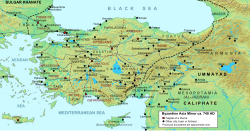Siege of Nicaea (727)
| Siege of Nicaea | |||||||
|---|---|---|---|---|---|---|---|
| Part of the Arab–Byzantine Wars | |||||||
 Map of Anatolia (Asia Minor) in 740 AD. Nicaea is located at the northwestern corner of the Anatolian peninsula | |||||||
| |||||||
| Belligerents | |||||||
| Byzantine Empire | Umayyad Caliphate | ||||||
| Commanders and leaders | |||||||
| Artabasdos |
Mu'awiya ibn Hisham Abdallah al-Battal | ||||||
The siege of Nicaea of 727 was an unsuccessful attempt by the
Background
Following the failure of the
After the accession of Caliph
Invasion of 727 and the siege of Nicaea
In summer 727,
From there, the Arabs turned west towards
Aftermath
The repulsion of the Arab assault on Nicaea was an important success for the Byzantines. Emperor
Militarily, the siege of Nicaea was the high-water-mark of the post-718 Umayyad raids; never again would Umayyad armies penetrate as deeply into Asia Minor.
References
- ^ Blankinship (1994), p. 117
- ^ Lilie (1976), p. 143
- ^ a b Makrypoulias (2003), Chapter 1
- ^ Blankinship (1994), pp. 117–118
- ^ Blankinship (1994), pp. 118–119
- ^ Blankinship (1994), pp. 119–120
- ^ Lilie (1976), p. 146
- ^ Some authors, notably Julius Wellhausen, date this expedition to 726, but the dating to 727 is confirmed by Theophanes' reference that it occurred "in the tenth indiction". Lilie (1976), p. 147 (Note 16)
- ^ a b c Blankinship (1994), p. 120
- ^ a b c d Lilie (1976), p. 147
- ^ Mango & Scott (1997), p. 560
- ^ Makrypoulias (2003), Note 3
- ^ Lilie (1976), p. 147 (Note 15)
- ^ Mango & Scott (1997), pp. 561–562 (Note 9)
- ^ Mango & Scott (1997), pp. 560–561
- ^ Makrypoulias (2003), Chapter 2
- ^ Lilie (1976), p. 147 (Note 16)
- ^ Makrypoulias (2003), Chapter 3
- ^ Mango & Scott (1997), pp. 560–562, incl. notes
- ^ Blankinship (1994), pp. 120–121
- ^ Blankinship (1994), pp. 121–125, 149–154
- ^ Lilie (1976), pp. 155–160
- ^ Blankinship (1994), pp. 167–170
- ^ Lilie (1976), pp. 148–153
Sources
- ISBN 978-0-7914-1827-7.
- Lilie, Ralph-Johannes (1976). Die byzantinische Reaktion auf die Ausbreitung der Araber. Studien zur Strukturwandlung des byzantinischen Staates im 7. und 8. Jhd (in German). Munich: Institut für Byzantinistik und Neugriechische Philologie der Universität München. OCLC 797598069.
- Makrypoulias, Christos (2003). Πολιορκία Νικαίας, 726-727. Encyclopaedia of the Hellenic World, Asia Minor (in Greek). Foundation of the Hellenic World. Retrieved 2010-10-14.
- ISBN 0-19-822568-7.
